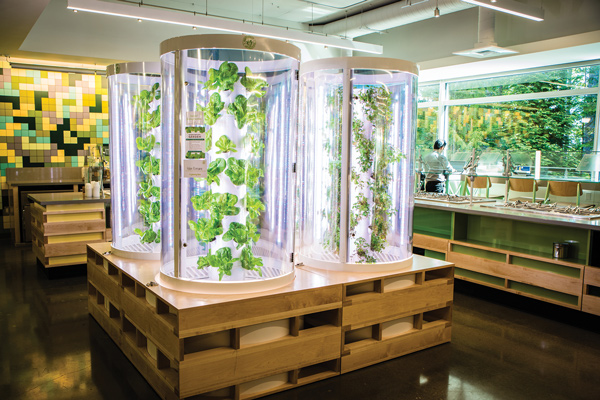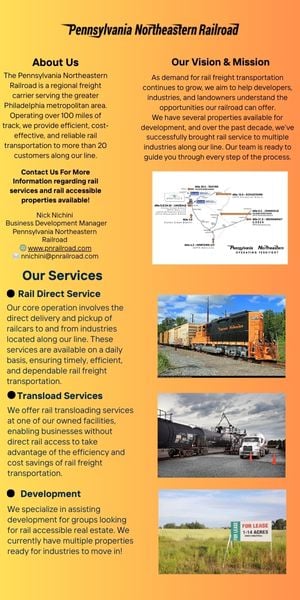Farm-to-table Dining Goes High Tech at Microsoft

Microsoft’s high-tech urban farming project provides employees and guests with thousands of pounds of lettuce and microgreens each year.
THE PEOPLE IN charge of Microsoft’s dining services think a lot about food. In particular, they think about how to provide delicious, healthful and sustainable food options to tens of thousands of people every day at dozens of dining venues at the company’s Puget Sound campus. Achieving this takes great creativity. Happily, Microsoft is known for thinking outside the box — or, in this case, far beyond the crates of prepackaged food.
Eleven years ago, Microsoft set a goal to serve better food to its employees and guests. Part of this involved what the company called the “culinary revolution,” which focused on making food from scratch instead of opening bags of prepared foods, dumping out the contents, then heating and serving them. Such foods are gone forever from Microsoft.
The Ingredient Revolution
This culinary revolution grew into an “ingredient revolution.” Employees today are more socially and ecologically conscientious. They want to understand everything about their food: how it’s prepared, where it was grown, how the farmers are treated, how the land is taken care of and so on. Microsoft now carefully considers all these issues for every kind of food that comes on-site. The company partners with organic suppliers and farms, prepares and cooks food in front of guests and tries to keep food sources close to home. (Microsoft also has a huge sustainability program for composting and managing dining waste.)
In the early days of Microsoft’s ingredient revolution, a few employees suggested installing roof gardens or community gardens, but no viable working model was available. A visit to an annual Seattle flower show introduced the dining services team leaders to hydroponic tower gardens — vertical, water-fed systems that can grow many plants in a small amount of floor space without soil.

Romaine lettuce and other greens grow in hydroponic towers maintained and managed with the help of the Microsoft Azure cloud computing platform at one of the company’s cafes.
From 2013 to 2015, the dining services staff set up towers as part of a pilot program to grow lettuce in the cafes where the greens would be used. The brightly lit grow towers caught everyone’s attention. Microsoft employees, visitors and customers were enamored with the plants, asked questions and took selfies in front of the leafy pillars. Chefs pulled lettuce from the grow towers to create salads and other dishes, and employees felt more confident about where their food was coming from. Moreover, Microsoft’s software developers soon offered to help automate the care of this on-site food supply.
Today, the company uses the Micro-soft Azure cloud computing platform to maintain and manage 39 hydroponic towers and 15 pyramid hydroponic units, which together provide about 5,000 growing sites for lettuce for the Puget Sound campus. That adds up to about 15,000 pounds of lettuce and other organic greens a year.
Microsoft also has a large microgreens program that includes 16 hydroponic cultivators inside the cafes. These put fresh, ready-to-pick herbs such as basil, cilantro, arugula and dill within easy reach of chefs. The cultivators grow all microgreens for the cafes (about 1,000 pounds a year) and can go from seed to harvest in just eight days. This extremely short farm-to-table path begins at on-campus nurseries, where all microgreens and lettuces are started from seeds.
High-tech Indoor Agriculture
As a software company, Microsoft applies technology to monitor the urban farms from anywhere on campus. Using data from sensors installed on the hydroponic units, for example, dining services farming staff can measure pH, water flow, humidity and nutrients. The farmers also track light levels and plant growth through video monitoring. A concise, easy-to-use dashboard shows each tower’s status, plant ages and overall health. The entire hydroponic system can be managed from a single tablet, smartphone or desktop computer because it’s all accessible through the cloud and can be viewed using easily programmed analytics and business intelligence tools.
The Benefits
In addition to providing high-quality produce to chefs and employees year round, the program offers Microsoft several other benefits. Growing produce close to the kitchen compresses the farm-to-table distance from many miles to a few feet. This yields fresher, tastier food and eliminates the environmental impacts of trucking it in. Hydroponic systems also use up to 90 percent less water than in-ground farming, and the little water they use is recycled throughout the hydroponic growing cycle. Kitchen staff also use less water preparing the produce because there is no dirt or pesticide to wash off.
One of the most interesting things about this urban farming project is how readily people at Microsoft got involved. The dining group started small but quickly demonstrated the value of what it was doing, which garnered senior leadership support. Employees continue to provide feedback, and the company’s software developers continue to innovate ways that cloud technologies can support growing food on-site.
Mark Freeman, senior manager, global dining, Microsoft
The BasicsWho: Microsoft and Mark Freeman, senior manager of Microsoft’s Global Dining Services. What: Organic hydroponic urban farming towers and microgreens trays producing 15,000 pounds of lettuces and 1,000 pounds of microgreens annually. Where: Microsoft’s campus in Redmond, Washington. When: Ongoing since 2013. Why: Provides employees with sustainable, responsible, locally sourced and delicious food. How: Under plasma, LED and fluorescent lights, lettuce and microgreens leaf out in more than 70 hydroponic grow towers, pyramids and urban microgreens cultivators, all managed and maintained remotely through the Microsoft Azure cloud computing platform. How Many: Started with one urban farmer; seven farmers currently provide greens for a campus with 45,000 employees. |







